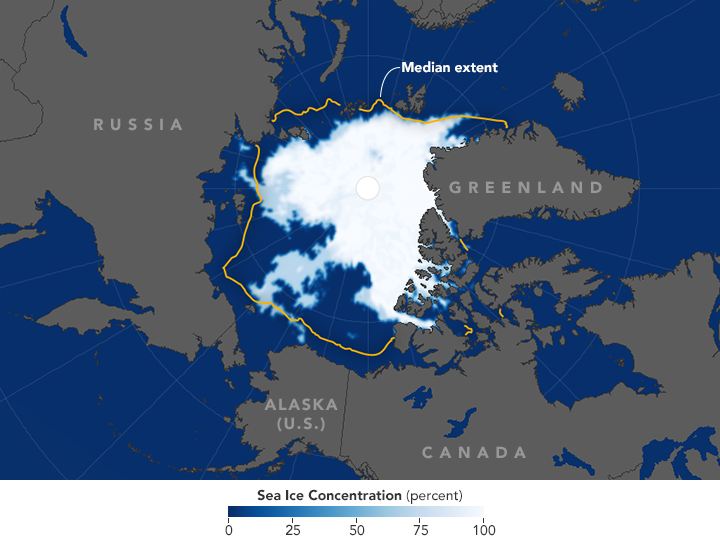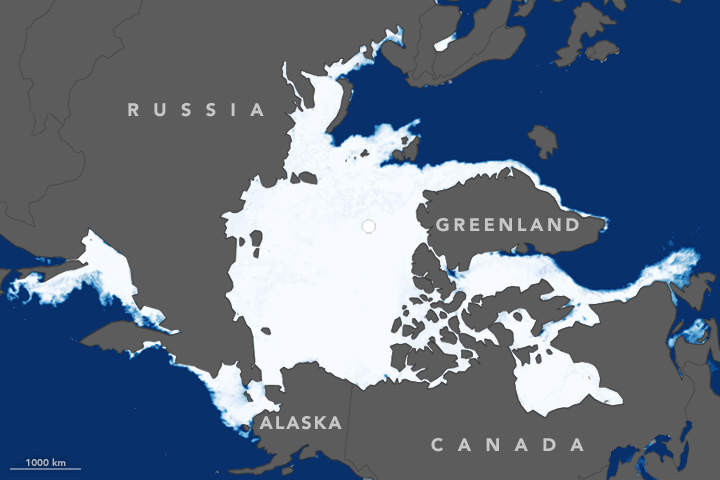The size of the ice cover in the Arctic Ocean broke the record minimum of 2007
According to the National Center for the Control of the Level of Ice and Snow (National Snow and Ice Data Center), in 2016 the size of ice covers in the Arctic Ocean reached its lowest point in the entire history of observations. The previous minimum was recorded nine years ago - in 2007.
Estimate the degree of melting of ice can be on the last picture of the NASA space observatory, which was done on September 10:

')
Median extent - the averaged boundaries within which the glacier exists, i.e. the density of ice cover in the specified area is at least 15%. Total ice arctic shield has decreased this year to a record small 4.14 million km 2 since the start of observations using orbiting satellites in 1979.
The reduction of the Arctic ice sheet is an annual phenomenon. Since the beginning of the polar day in March and to its end in September, the Arctic has seen the melting of ice, which are recovering from the onset of the polar night. Since the beginning of the observations, the dimensions of the ice sheet have been constantly decreasing. In addition, this year was a record not only in terms of the rate of melting ice, but also in terms of the initial size of the glacier in March. For comparison, the processed images are given for March 1983 (then the dimensions of the glacier reached their maximum in the entire history of observations) and 2016, where the white circle indicates a solid ice sheet:

Arctic ice shield in 1983

Arctic ice shield in 2016
The maximum area of the glacier this year was 14.52 million km 2 , which is a record minimum of the maximum size of the glacier for all the years of observation. The previous anti-record was delivered a year earlier, in February 2015. Then the area of the Arctic ice sheet was 14.54 million km 2, and a similar trend has persisted over the past 13 years.
Since 1979, the loss of the Arctic ice sheet in size is estimated at 1.6 million km 2 .
Arctic ice cover is extremely dependent on the weather on the planet. If the period from December to February, when the glacier is gaining its main strength, is given out warm, then the ice cannot move south too far. But the main problem is not seasonal conditions - one year may be warmer, the other - colder, and the general rise in temperature of the world’s ocean.
Most of the Arctic ice is formed in the Arctic Ocean and the higher temperature of the water stops the growth of the glacier, and the subsequent natural melting in the summer period leads to a permanent reduction in its area over the past 13 years.
On the other hand, the growth of ice cover is observed in the Antarctic, which, however, does not overlap the overall negative dynamics of the planet:

Melting ice chart for the period from 1983 to 2013
There is a common misconception that the ice forming in the Antarctic somehow compensates for the loss of the Arctic ice sheet, however, this is not so.
Reducing the size of Arctic ice can lead to severe climatic consequences, as well as endanger the existence of thousands of species living in cold northern waters or dependent on their inhabitants.
Estimate the degree of melting of ice can be on the last picture of the NASA space observatory, which was done on September 10:

')
Median extent - the averaged boundaries within which the glacier exists, i.e. the density of ice cover in the specified area is at least 15%. Total ice arctic shield has decreased this year to a record small 4.14 million km 2 since the start of observations using orbiting satellites in 1979.
The reduction of the Arctic ice sheet is an annual phenomenon. Since the beginning of the polar day in March and to its end in September, the Arctic has seen the melting of ice, which are recovering from the onset of the polar night. Since the beginning of the observations, the dimensions of the ice sheet have been constantly decreasing. In addition, this year was a record not only in terms of the rate of melting ice, but also in terms of the initial size of the glacier in March. For comparison, the processed images are given for March 1983 (then the dimensions of the glacier reached their maximum in the entire history of observations) and 2016, where the white circle indicates a solid ice sheet:

Arctic ice shield in 1983

Arctic ice shield in 2016
The maximum area of the glacier this year was 14.52 million km 2 , which is a record minimum of the maximum size of the glacier for all the years of observation. The previous anti-record was delivered a year earlier, in February 2015. Then the area of the Arctic ice sheet was 14.54 million km 2, and a similar trend has persisted over the past 13 years.
Since 1979, the loss of the Arctic ice sheet in size is estimated at 1.6 million km 2 .
Arctic ice cover is extremely dependent on the weather on the planet. If the period from December to February, when the glacier is gaining its main strength, is given out warm, then the ice cannot move south too far. But the main problem is not seasonal conditions - one year may be warmer, the other - colder, and the general rise in temperature of the world’s ocean.
Most of the Arctic ice is formed in the Arctic Ocean and the higher temperature of the water stops the growth of the glacier, and the subsequent natural melting in the summer period leads to a permanent reduction in its area over the past 13 years.
On the other hand, the growth of ice cover is observed in the Antarctic, which, however, does not overlap the overall negative dynamics of the planet:

Melting ice chart for the period from 1983 to 2013
There is a common misconception that the ice forming in the Antarctic somehow compensates for the loss of the Arctic ice sheet, however, this is not so.
Reducing the size of Arctic ice can lead to severe climatic consequences, as well as endanger the existence of thousands of species living in cold northern waters or dependent on their inhabitants.
Source: https://habr.com/ru/post/397713/
All Articles